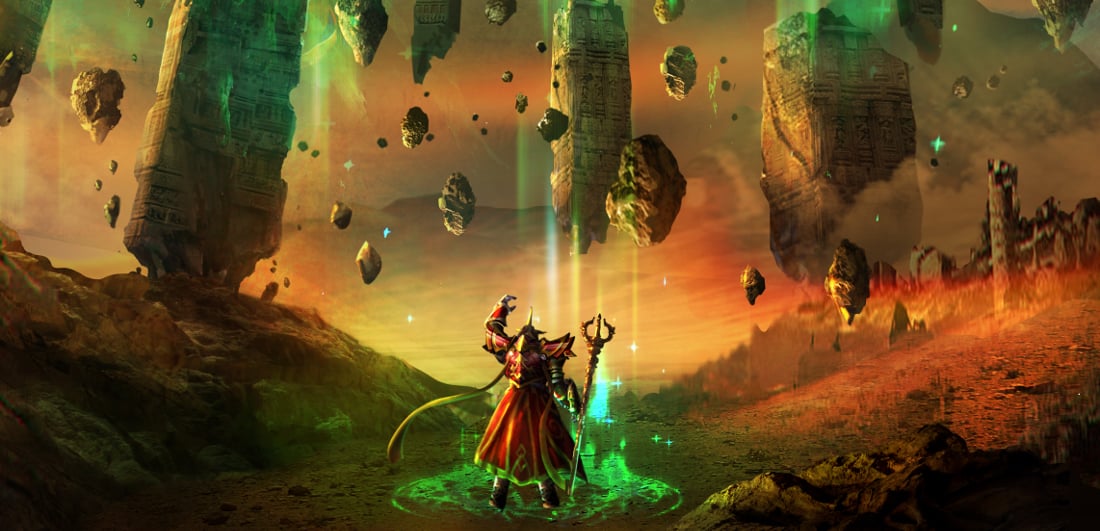Rune Knight 5E Guide | Fighter Archetype in Tasha’s Cauldron
Tasha’s Cauldron of Everything seems to really like its versatile and interesting subclasses. The Rune Knight is no exception! As a Rune Knight, you harness the power of the Giants to enchant weapons and armor around you. You’ve either worked with Giants until you are in harmony with them, or the Giants have blessed you. Either way, you can use their ability to grow to an immense size! You’re far from a simple blacksmith, and our Rune Knight 5E guide will show you!

See Our Tasha’s Cauldron Subclasses Guide.
Table of Contents
Build to Power: Rune Knight 5E
The Rune Knight is a resource-based archetype for the Fighter D&D class with a focus on having huge bursts of potent damage. This is through their Rune mechanic, and their Giant’s Might mechanic. It is incredibly important to space out your uses of Runes and Giant’s Might effectively to be a threat on the battlefield. Otherwise, you’ll find that this archetype’s strength is quite focused on limited uses, and leans a lot on base fighter features to be good otherwise.
Bonus Proficiencies
To start, some flavor. At level 3…
You gain proficiency with smith’s tools, and you learn to speak, read, and write Giant.
Neat. Smith’s tools tend to be useful, since a lot of creatures use metal weapons and armor. You can fix them if they break, or make new ones if you need. A Rune Knight should make their own weapons, basically as a right of passage! However, tools tend to be a little bit situational, so don’t be surprised if you never roll your smith’s tools check, without some talking with your DM first.
Rune Carver
Also at level 3, you get your two main mechanics. Your first is the rune system. Rune Knights gain runes equal to the below table.
| Fighter Level | Number of Runes |
| 3rd | 2 |
| 7th | 3 |
| 10th | 4 |
| 15th | 5 |
Every time you gain a level in the class, you can swap a rune for another rune.
Whenever you finish a long rest, you can touch a number of objects equal to the number of runes you know, and you inscribe a different rune onto each of the objects. To be eligible, an object must be a weapon, a suit of armor, a shield, a piece of jewelry, or something else you can wear or hold in a hand. Your rune remains on an object until you finish a long rest, and an object can bear only one of your runes at a time.
These runes can have a level requirement. If they have a saving throw, the DC is Constitution-based (8 + your proficiency + Constitution mod).
- Cloud Rune: Great for sneaky characters, with Sleight of Hand and Deception advantage. Then, you can invoke the rune to transfer an attack from one enemy to another within 30 feet of you to another within 30 feet of you. That’s… absolutely insane! You can save so much health once per rest, which is perfect for you! They can’t even save to ignore this effect! This is a great rune to learn.
- Fire Rune: You double proficiency bonus for a tool that you know. You invoke shackles, which require a Strength save. No matter what, they take 2d6 fire damage. If they fail, they become restrained, and take 2d6 at the start of every turn. They can try to save at the end of their turn, but… that’s a lot of damage, and good crowd control! Hold Person (not quite) on a weapon swing isn’t bad at all!
- Frost Rune: Advantage on Animal Handling and Intimidation checks. Then, invoking this rune gives you a +2 to Strength and Constitution saving throws or ability checks for 10 minutes. This is probably the weakest rune in general, but it lasts a while. There are reasons to take this rune, but none of them are… stellar.
- Stone Rune: Advantage on Insight, and gain 120 feet of Darkvision. In addition, you can invoke the rune to Charm a target, with a Wisdom save. The charm incapacitates them and lowers their speed to 0. This is yet another rune that completely takes a target out of a fight. Unlike the Fire Rune, this one doesn’t do much damage, so it’s much more useful out of combat, while still being fine in combat!
- Hill Rune (7th): You are much better against anything that involves poison; advantage on saves and resistance against damage. Then, you can invoke them to gain resistance against physical damage for a minute. That’s pretty good; you can give yourself the primary reason to take Barbarian Rage as a fighter! That’s worthwhile.
- Storm Rune (7th): You have advantage on… Arcana checks? And you can’t be surprised. As a bonus action, you can invoke it to enter a prophetic state, giving attack rolls, saving throws, or ability checks nearby advantage or disadvantage as a reaction, with no save. That can really mess with a battlefield! Get this rune quick, since it’s actually really useful, and action-efficient!
You should choose runes which synergize with your party. If you’re not sure what to take (and don’t worry, this is a pretty weird class!), we recommend the following;
Fire/Stone -> Hill -> Storm -> Cloud -> Fire/Stone (whichever you didn’t take).
Since you can swap runes every level, feel free to swap them around if you find that you’re not invoking them too often! Hill and Storm are super modular, based on your party. Take Storm first if your party doesn’t need a tank. While I’m not a fan of the Frost rune, it’s definitely worthwhile if you go into bad environments.
Giant’s Might
That’s not all you get at level 3! You can also imbue yourself with the might of giants!
As a bonus action, you magically gain the following benefits, which last for 1 minute:
- If you are smaller than Large, you become Large, along with anything you are wearing. If you lack the room to become Large, your size doesn’t change.
- You have advantage on Strength checks and Strength saving throws.
- Once on each of your turns, one of your attacks with a weapon or an unarmed strike can deal an extra 1d6 damage to a target on a hit.
You can use this a Proficiency Modifier number of times per Long Rest. These buffs are fairly grand! You become big, which is actually a debuff. It’s easier to hit you and you can’t sneak through smaller areas. It’s easier to hit you with area of effect spells, and harder for you to get cover. However, you are also harder to get around, you have more threatened squares, and you can block hallways much better. It’s not bad, but not good.
The other two are hard buffs! Advantage on Strength checks and saving throws are strictly good. Strength checks are commonplace for Fighters, and advantage on those can help you solve problems… or let you become a good grappler! That’s right, this can totally be a grapple build! Strength saves are not too common, but you’ll be happy to be a Giant when you need to make one.
Finally, you do an average of 4 extra damage per turn. That’s fine, but relatively minor. Remember that you have this, but you might want to use Giant’s Might in a situation where you can really use your Strength checks/Saves and large size to its fullest!
Runic Shield
Phew! That was a lot of class features! You get a break until level 7.
You learn to invoke your rune magic to protect your allies. When another creature you can see within 60 feet of you is hit by an attack roll, you can use your reaction to force the attacker to reroll the d20 and use the new roll.
You can use this feature a number of times equal to your proficiency bonus, and you regain all expended uses when you finish a long rest.
Cool. You don’t give them disadvantage, so you can give someone disadvantage and then reroll the d20. You can also use this at most ranges, since 60 ft is a ton. This is a great defensive ability!
However, it’s pretty limited. You only get your charges back once per day, and you can’t get more than 6 no matter what. Use it to protect your less tanky party levels, rather than your fellow melee characters. Protecting your Cleric, for example, can pay off in dividends. And your Wizard might need this to even stay alive.
Not much else to say. It’s just good! Just watch your resources.
Great Stature
And things just keep getting better! At level 10, you get this.
The magic of your runes permanently alters you. When you gain this feature, roll 3d4. You grow a number of inches in height equal to the roll.
Moreover, the extra damage you deal with your Giant’s Might feature increases to 1d8.
Ugh, more Giant’s Might synergy… And one is strictly flavor! Okay, so there are theoretically benefits for being a foot taller, but usually not. Maybe you can get on a bigger rollercoaster or something.
Your Giant’s Might now deals an average of 5 more damage a turn. While far from nothing, the Fighter benefits mostly from the Extra attack class feature. This doesn’t synergize that well with that, instead just being a small extra burst of damage. At least it’s keeping up with the extra health that enemies have now.
Master of Runes
At level 15, you get the first major buff to your runes.
You can invoke each rune you know from your Rune Carver feature twice, rather than once, and you regain all expended uses when you finish a short or long rest.
Cool, but pretty simple. You now no longer have to wait for the best time per rest to use your runes. You have two charges now, so you can get pretty amazing benefits out of using them whenever you feel threatened. No longer worry about needing to save them for the “best possible time”.
This is great, and makes your runes even more useful than they were in the past. That’s just impressive, really!
Runic Juggernaut
Your final, level 18 ability is another buff to Giant’s Might. And, you know what… I finally like it!
You learn how to amplify your rune-powered transformation. As a result, the extra damage you deal with the Giant’s Might feature increases to 1d10. Moreover, when you use that feature, your size can increase to Huge, and while you are that size, your reach increases by 5 feet.
First of all, you gain 6 average damage on your Giant’s Might. Sure. Good. I’m still not impressed by it, but at least the damage continued to scale so that you have a reason to use Giant’s Might in boss fights.
The more important thing is Huge. Huge has the same problems as Large, in that you’re easier to hit and can’t use cover. But your threaten squares cover an absolutely absurd amount of the battlefield. In addition, you can now grapple or shove most creatures in the game. That’s a pretty good amount of combat control! With a reach of 5 feet, there won’t be many creatures not accidentally running into your radius. And then you can chain them with fire, or use Sentinel to keep the battle exactly as you want it.
You have 6 uses of Giant’s Might at this point, and you should feel comfortable using it whenever you’re worried about a fight going even remotely poorly.
Best Race for Rune Knight Fighters
Interestingly enough, the Rune Knight has no specifications about melee attacks. You can be a ranged Rune Knight if you really want to! However, because of the benefits of Large, you’re best being a melee fighter, using Strength and Heavy Armor or Dexterity and Light armor, to lock down enemies. Dexterity isn’t too bad, since you can still use the advantage on Strength checks to try desperately to make a Strength check with 10 Strength.
Goliath
The Goliath race is the most obvious choice for a reason. +2 Strength, +1 Constitution is exactly what you were looking for. Natural Athlete and Powerful Build are both great for your role as an athletics-based superstar, and Stone’s Endurance will easily keep you alive. These might be obvious, but dang if they aren’t effective!
Human
I’m dead serious; this is probably the best Fighter archetype for grappling. The ability to increase in size is crucial for a Grappler to be useful against important enemies like Dragons. And you can increase to Huge! As a Human, you can get Strength and Constitution. Then, with your Variant Feat, you can get either Tavern Brawler or Grappler, whatever works better for you. We suggest Tavern Brawler, and using runes to restrain a grappled creature, thus replacing the need for Grappler.

Rune Knight 5E FAQ
Is Rune Knight Fun to Play?
Whether or not the Rune Knight is fun to play is subjective, but there are two reasons why I point to it as a fun option. First, it is highly thematic. The interplay between giants and rune magic is interesting, and building a character around that has a lot of potential no matter how optimized your character might be. Second, it is a departure from some of the more vanilla fighter subclass options. Your rune magic provides you with some meaningful choices that might not come up when you are playing the Champion 5E archetype, for example.
Can You Use Runic Shield on Yourself?
No, you can’t use Runic Shield on yourself. The language of the feature spells out that it only applies to “another creature,” meaning anyone but you.
Does Giant’s Might Increase Your Reach?
Yes, while Giant’s Might is active your size increases to Huge and your reach increases by 5 feet.
What Book is the Rune Knight Found in?
You can get the Rune Knight martial archetype in Tasha’s Cauldron of Everything.
Conclusion – Our Take on the Rune Knight 5E
The Rune Knight seems strong for a 5E fighter archetype, but it’s so resource-based that it works only if you’re careful. You can easily waste all of your resources and then be stuck with basic Fighter features until your next rest. So, if you like the resource-based fighter style, check this class out! And check out some other Tasha’s Cauldron archetypes, because this book loves those!






